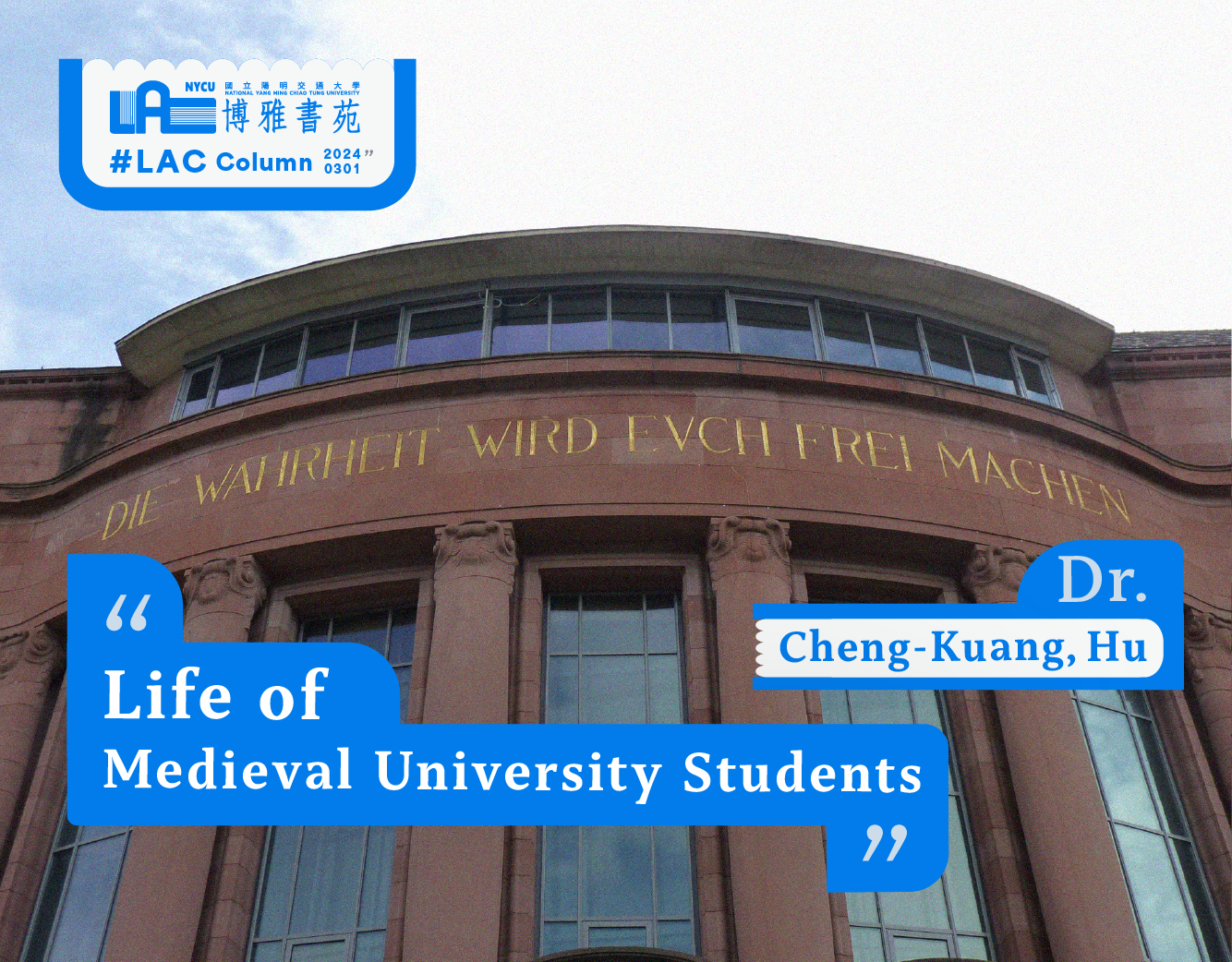- Home
- LAC COLUMN
- Life of Medieval University Students—Cheng-Kuang, Hu
Life of Medieval University Students—Cheng-Kuang, Hu
Life of Medieval University Students
In today's universities, colleges are academic units, and universities established in the post-industrial age often organize disciplines into colleges, so a college is a collection of related departments. The Latin origin of the term roughly aligns with this idea, meaning "selected items gathered together." However, in the Middle Ages, universities were not planned entities. It was not possible, as it is today, to determine the number of colleges and departments before the establishment of the university.
Initially, universities were voluntary associations of scholars and students who wanted to learn. Students seeking knowledge would find scholars willing to teach and form guilds to protect themselves, laying the groundwork for universities. This time, we won't discuss the academic aspect of university life. Instead, we'll focus on the daily lives of students.
When students first arrived from out of town, they would stay in inns. Teachers would come to promote their courses and attract students. Those willing to attend lectures could reside in dormitories managed in the name of the lecturer, although the administration was handled by senior students in reality. This accommodation was later mandated by Oxford and Paris Universities unless students were nobles living in their own homes or impoverished students unable to afford lodging. This explains why colleges are referred to as "communities of life." Teachers not only impart knowledge but also oversee student life.
The dormitory life was quite free, with simple rules. Unless one committed serious misconduct, they would not be imprisoned or expelled from the church. Generally, except for poor students, the financial situation of medieval university students was decent. They were economically secure and young, away from home and unrestrained, leading quite comfortable lives. Many of the letters passed down to this day involve young people reaching out to their families for financial assistance, and fathers reproaching their sons for neglecting their studies.
Violence was widespread in the Middle Ages, and it was not uncommon in universities either. The regulations drafted by Leipzig University in 1438 include penalties for throwing stones or other objects at teachers. Brawling under the influence of alcohol was also common among students. Even more puzzling, there was often animosity between university students and town residents, leading to serious conflicts. In 1200, unruly behavior by Parisian students (before the organization of the University of Paris) outraged the residents, resulting in the killing of five students. In protest, the academic community appealed to King Philip II, who granted privileges to scholars and students to appease them. However, conflicts persisted, leading to the migration of academic communities to other towns to continue their studies, thus giving rise to new universities. Cambridge University was established by the migration of scholars and students from Oxford, while those from Paris populated the universities in Toulouse and Orleans. It can be said that the penchant for trouble among university students inadvertently promoted academic expansion.
Caption: "Die Wahrheit wird euch frei machen" (Photographed at Universität Freiburg, Germany)

In today's universities, colleges are academic units, and universities established in the post-industrial age often organize disciplines into colleges, so a college is a collection of related departments. The Latin origin of the term roughly aligns with this idea, meaning "selected items gathered together." However, in the Middle Ages, universities were not planned entities. It was not possible, as it is today, to determine the number of colleges and departments before the establishment of the university.
Initially, universities were voluntary associations of scholars and students who wanted to learn. Students seeking knowledge would find scholars willing to teach and form guilds to protect themselves, laying the groundwork for universities. This time, we won't discuss the academic aspect of university life. Instead, we'll focus on the daily lives of students.
When students first arrived from out of town, they would stay in inns. Teachers would come to promote their courses and attract students. Those willing to attend lectures could reside in dormitories managed in the name of the lecturer, although the administration was handled by senior students in reality. This accommodation was later mandated by Oxford and Paris Universities unless students were nobles living in their own homes or impoverished students unable to afford lodging. This explains why colleges are referred to as "communities of life." Teachers not only impart knowledge but also oversee student life.
The dormitory life was quite free, with simple rules. Unless one committed serious misconduct, they would not be imprisoned or expelled from the church. Generally, except for poor students, the financial situation of medieval university students was decent. They were economically secure and young, away from home and unrestrained, leading quite comfortable lives. Many of the letters passed down to this day involve young people reaching out to their families for financial assistance, and fathers reproaching their sons for neglecting their studies.
Violence was widespread in the Middle Ages, and it was not uncommon in universities either. The regulations drafted by Leipzig University in 1438 include penalties for throwing stones or other objects at teachers. Brawling under the influence of alcohol was also common among students. Even more puzzling, there was often animosity between university students and town residents, leading to serious conflicts. In 1200, unruly behavior by Parisian students (before the organization of the University of Paris) outraged the residents, resulting in the killing of five students. In protest, the academic community appealed to King Philip II, who granted privileges to scholars and students to appease them. However, conflicts persisted, leading to the migration of academic communities to other towns to continue their studies, thus giving rise to new universities. Cambridge University was established by the migration of scholars and students from Oxford, while those from Paris populated the universities in Toulouse and Orleans. It can be said that the penchant for trouble among university students inadvertently promoted academic expansion.
Caption: "Die Wahrheit wird euch frei machen" (Photographed at Universität Freiburg, Germany)

